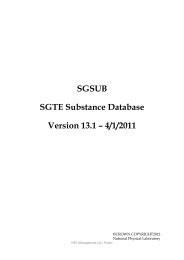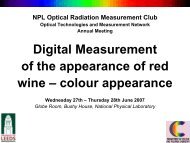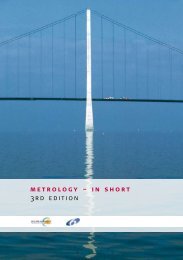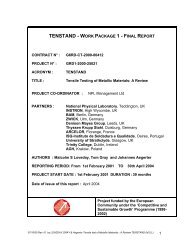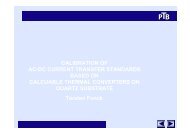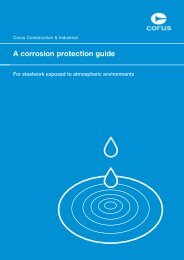EA-10/16 - National Physical Laboratory
EA-10/16 - National Physical Laboratory
EA-10/16 - National Physical Laboratory
Create successful ePaper yourself
Turn your PDF publications into a flip-book with our unique Google optimized e-Paper software.
<strong>EA</strong>-<strong>10</strong>/<strong>16</strong> • <strong>EA</strong> Guidelines on the Estimation of Uncertainty in Hardness Measurements<br />
2.3.2 Vibrations, electrical interference and lack of cleanliness, can cause<br />
significant problems that are difficult to quantify. Ultra-low force<br />
microhardness measurements of course require an absolutely vibration-free<br />
environment, whereas vibration requirements for test forces above 200 mN<br />
are not so critical.<br />
2.4 Operator<br />
Measurement positions on the surface of the sample become important in<br />
many cases. Measurements, for instance, near the edge of a piece or at<br />
points close to each other must be properly located to ensure accurate<br />
results. Uncertainties of up to 2 HRC are not uncommon here. Overall<br />
monitoring of the operation is very important. Some modern testing machines<br />
have features that minimise operator influence; nevertheless, the latter is still<br />
essential for a successful hardness measurement.<br />
3 GENERAL PROCEDURE FOR CALCULATING THE UNCERTAINTY OF<br />
HARDNESS M<strong>EA</strong>SUREMENT<br />
The following procedure is based on <strong>EA</strong>/4-02 [1] (cf. worked examples in<br />
section 4).<br />
a) Express the relationship between the measured hardness H (output<br />
quantity) and the input quantities X i (model function) in mathematical<br />
terms:<br />
H = f(X 1 ,X 2 ,...,X N ) (1)<br />
Notice that in the case of Hardness a mathematical relationship<br />
connecting input quantities X i with the output quantity H is not known at<br />
the state of the art. The connection is given by the scale definitions that<br />
are empirical procedures. The model function, therefore, does not give<br />
much more than a list of factors affecting the measurement results. In<br />
practice this is sufficient for establishing a procedure based on <strong>EA</strong>/4-02,<br />
providing that special care is adopted for evaluating standard<br />
uncertainties of the input quantities and sensitivity coefficients, as shown<br />
here after.<br />
b) Identify and apply all significant corrections.<br />
c) List all sources of uncertainty in the form of an uncertainty analysis in<br />
accordance with the following table:<br />
July 05 rev.00 Page <strong>10</strong> of 24



